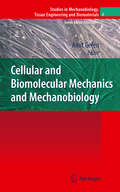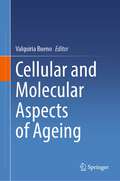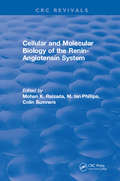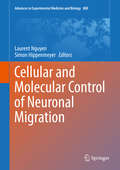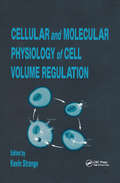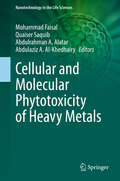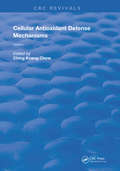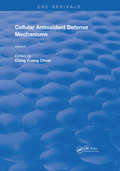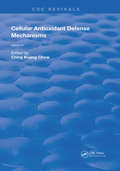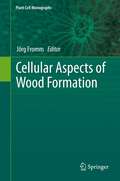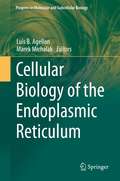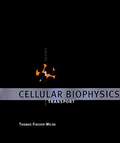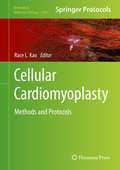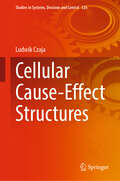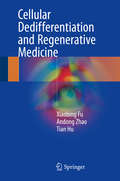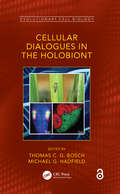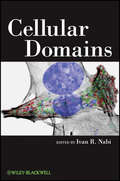- Table View
- List View
Cellular and Biomolecular Mechanics and Mechanobiology (Studies in Mechanobiology, Tissue Engineering and Biomaterials #4)
by Amit GefenThis book describes these exciting new developments, and presents experimental and computational findings that altogether describe the frontier of knowledge in cellular and biomolecular mechanics, and the biological implications, in health and disease. The book is written for bioengineers with interest in cellular mechanics, for biophysicists, biochemists, medical researchers and all other professionals with interest in how cells produce and respond to mechanical loads.
Cellular and Molecular Aspects of Ageing
by Valquiria BuenoEven though life expectancy increased in the last decades, ageing has been considered a strong risk factor for age-related diseases, disability and death. The further understanding of cellular and molecular aspects of ageing could predict the onset of diseases in advance, prevent functional decline and identify targets for interventions focused in healthy ageing. The hypothesis that organismal ageing and dysfunction is influenced by the accumulation of senescent cells had origin in Hayflick and Moorhead results from cultured human fibroblasts. It was shown that fibroblasts presented a limited capacity for proliferation reaching thus the state of irreversible growth arrest (replicative senescence). In 2011, van Deusen et al. showed that p16Ink4a accumulation was associated with premature ageing in a mouse model and the inactivation of the p16Ink4a gene mitigated the ageing phenotype. Thus, the cell cycle arrest due to the expression of p16Ink4a and p21CIP (cell cycle inhibitors) is the main characteristic of senescence. In addition to cellular senescence, the hallmarks of ageing include genomic instability, telomere shortening , epigenetic alterations, loss of proteostasis, deregulated nutrient-sensing, mitochondrial dysfunction, stem cell exhaustion, altered intercellular communication, and a pro-inflammatory senescence-associated secretory phenotype (SASP). In this book, researchers will comprehensively discuss relevant changes occurring at cellular and molecular levels (human and animal models) based on the hallmarks of ageing. The impact of lifestyle and benefits of physical activity and nutrition will be also discussed. Unravelling cellular and molecular aspects of ageing is crucial for the unanswered questions about ageing and for guiding interventions such as changes in lifestyle, senolytic (kills senescent cells), and senomorphic (interrupts deleterious intercellular communication) therapies.
Cellular and Molecular Basis of Mitochondrial Inheritance: Mitochondrial Disease and Fitness (Advances in Anatomy, Embryology and Cell Biology #231)
by Peter SutovskyThis new volume of our successful book series Advances in Anatomy, Embryology and Cell Biology is focused on mitochondrial inheritance in humans and both vertebrate and invertrebate animals including Drosophila, C. elegans, bivalve molusc Mytilus and livestock mammals. Special consideration is given to cellular mechanisms promoting uniparental inheritance of mitochondria and mitochondrial genes, evolutionary perspectives, and biomedical and epidemiological considerations. Contributed by five distinguished mitochondrial research teams from around the world, this volume will target a wide audience of physiologists, anatomists, cell, and developmental and evolutionary biologists, as well as physicians, veterinarians, livestock specialists and biomedical researchers.
Cellular and Molecular Biology of Metals
by Rudolfs K. Zalups D. James KoropatnickWith chapter contributions from more than 30 metal biology experts, Cellular and Molecular Biology of Metals explains the role of key divalent metal ions involved in the molecular and cellular biology of various target cell populations. Although it primarily focuses on homeostatic metals, such as nickel, zinc, and chromium, the text also discusses
Cellular and Molecular Biology of Nitric Oxide
by Jeffrey D. Laskin Debra L. Laskin"Provides the latest advances in the explosive growth of nitric oxide (NO) study-covering the behavior of this highly reactive molecule in a wide variety of physiologicial processes, including respiration, blood pressure, neurotransmission, nospecific host defense, and wound healing."
Cellular and Molecular Biology of the Renin-Angiotensin System
by Mohan K. RaizadaCellular and Molecular Biology of the Renin-Angiotensin System provides the first review and update of the state-of-the-art cellular and molecular aspects of the renin-angiotensin system. The book presents detailed analyses from world experts on each component of this system, including future directions. Topics range from angiotensin II receptor subtypes to processing of renin to the use of transgenic animal models for studying the role of this system in hypertension. Cellular and Molecular Biology of the Renin-Angiotensin System is essential reading for physiologists of the renin-angiotensin system, endocrinologists, cardiovascular specialists, renal physiologists, and neurobiologists.
Cellular and Molecular Control of Neuronal Migration (Advances in Experimental Medicine and Biology #800)
by Laurent Nguyen Simon HippenmeyerCellular and Molecular Control of Neuronal Migration provides an up-to-date collection of reviews on the molecular and cellular principles of neuronal migration in the mammalian brain. Over the last decades a rich catalogue of signaling molecules controlling neuronal migration has been compiled, and within this book an international panel of experts provides up-to-date discussions of the state of knowledge how these distinct signaling pathways regulate various aspects of neuronal migration. This book introduces the reader to the latest discoveries and concepts of neuronal migration enabled through the application of most sophisticated methods and cutting edge experimental approaches. Cellular and Molecular Control of Neuronal Migration also provides an update on the underlying cellular and molecular basis of neurodevelopmental migration disorders in human patients for all interested neuroscientists and clinicians.
Cellular and Molecular Physiology of Cell Volume Regulation
by Kevin StrangeThe ability to regulate cell volume in the face of osmotic challenge is one of the most fundamental of cellular homeostatic mechanisms. Cellular and Molecular Physiology of Cell Volume Regulation is an integrated collection of articles describing key aspects of cell volume control. The book has been organized around concepts and cellular/molecular processes rather than around mechanisms of volume regulation in specific cell types in order to make it more accessible to a multidisciplinary audience of students, instructors, and researchers.
Cellular and Molecular Phytotoxicity of Heavy Metals (Nanotechnology in the Life Sciences)
by Mohammad Faisal Quaiser Saquib Abdulrahman A. Alatar Abdulaziz A. Al-KhedhairyPlant growth and development is closely dependent on the plant environment, including the wide-spread presence of organic and inorganic xenobiotics and pollutants. Currently, heavy metals are the most common inorganic environmental pollutants and they have pronounced effects and consequences not only for plants, but also for the ecosystem in which the plants form an integral component. It has been suggested that these contaminants accumulate in agricultural crops, thus entering the food chain and posing a significant health risk. Plants growing in polluted sites exhibit altered metabolism, reduced growth, and decreased biomass production. These pollutants adhere to plant roots and exert physical or chemical toxicity and subsequently cell death in plants. Yet, plants have developed various defence mechanisms to counteract the toxicity induced by heavy metals. Only detailed study of the processes and mechanisms would allow researchers and students to understand the interactions, responses, and adaptations of plants to these pollutants; however, there are several unresolved issues and challenges regarding the interaction and biological effects of heavy metals. Therefore, this volume provides relevant, state-of-the-art findings on environmental phytotoxicity and the mechanisms of such interactions at the cellular and molecular levels. This volume consists of chapters on relevant topics contributed by different experts or group of experts so as to make available a comprehensive treatise designed to provide an in-depth analysis of heavy metals phytotoxicity. This book may serve as a reference to scientists, researchers and students in the fields of toxicology, environmental toxicology, phytotoxicology, plant biology, plant physiology, plant biochemistry and plant molecular biology, and especially those interested in heavy metals toxicology.
Cellular and Molecular Toxicology of Nanoparticles
by Quaiser Saquib Mohammad Faisal Abdulaziz A. Al-Khedhairy Abdulrahman A. AlatarThis edited book is a compilation of findings on the molecular and cellular toxicity of nanoparticles (NPs) in animal cell, human cells, invertebrates. The varied selection of test models will provide better understanding about the horizon of NPs toxicity. Interaction of NPs with cells and its organelles can induce toxicological consequences, including transcriptional and translational alterations, DNA damage, cytotoxicity, oxidative stress, mitochondrial dysfunction and cell death. NPs can get internalized in cells through phagocytosis, macropinocytosis, receptor-mediated endocytosis and passive penetration, which can affect varied cell types. Readers will be benefited with the compilations on basic and molecular facet of NPs toxicity. The chapters will provide a comprehensive information on the state-of-the-art methodologies. The application of toxicogenomic approaches, which is already established in nanotoxicology, has been given special consideration to unravel the toxicodynamics of nanomaterials. Among these approaches, the high-throughput RNA sequencing (RNA-Seq), which is able to build a complete map of transcriptome across different cell types and perturbations upon NPs exposure has been included. The readers are also introduced to the less studied topic on the adsorption of biomolecules (mainly proteins) on the NPs surface, constituting the so-called “biomolecular corona”. The book has been designed for scientists engaged in NPs toxicity research. Nonetheless, it should be of interest to a variety of scientific disciplines including marine biology, environmental pollution, genetics, pharmacology, medicine, drug and food material sciences, consumer products. Also, the compilations will be of interest to the environmental watchdogs, federal regulators, risk assessors and the policy makers.
Cellular and Subcellular Nanotechnology: Methods and Protocols (Methods in Molecular Biology #991)
by Volkmar Weissig Tamer Elbayoumi Mark OlsenIn Cellular and Subcellular Nanotechnology: Methods and Protocols expert researchers in the field detail the most recent advances which have been made in utilizing the enormous potential of nanotechnology for probing, imaging and manipulating life on a cellular and subcellular level. Written in the highly successful Methods in Molecular BiologyTM series format, chapters include introductions to their respective topics, lists of the necessary materials and reagents, step-by-step, readily reproducible laboratory protocols, and key tips on troubleshooting and avoiding known pitfalls. Authoritative and Practical, Cellular and Subcellular Nanotechnology: Methods and Protocols seeks to aid scientists in the further study of applying nanotechnology to all areas of biomedical sciences.
Cellular Antioxidant Defense Mechanisms (Routledge Revivals #1)
by Ching Kuang ChowFirst Published in 1988, this three volume set offers a full insight into the immune system and its response to antioxidants. Carefully compiled and filled with diagrams, references and information this set is recommended for students of immunology and other professionals in their respective fields.
Cellular Antioxidant Defense Mechanisms (Routledge Revivals #2)
by Ching Kuang ChowFirst Published in 1988, this three-volume set offers a full insight into the immune systems and its response to antioxidants. Carefully compiled and filled with diagrams, references and information this set is recommended for students of immunology and other professionals in their respective fields.
Cellular Antioxidant Defense Mechanisms (Routledge Revivals #3)
by Ching Kuang ChowFirst Published in 1988, this three-volume set offers a full insight into the immune systems and its response to antioxidants. Carefully compiled and filled with diagrams, references and information this set is recommended for students of immunology and other professionals in their respective fields.
Cellular Aspects of Wood Formation (Plant Cell Monographs #20)
by Jörg FrommWith today's ever growing economic and ecological problems, wood as a raw material takes on increasing significance as the most important renewable source of energy and as industrial feedstock for numerous products. Its chemical and anatomical structure and the excellent properties that result allow wood to be processed into the most diverse products; from logs to furniture and veneers, and from wood chippings to wooden composites and paper. The aim of this book is to review advances in research on the cellular aspects of cambial growth and wood formation in trees over recent decades. The book is divided into two major parts. The first part covers the basic process of wood biosynthesis, focusing on five major steps that are involved in this process: cell division, cell expansion, secondary cell wall formation, programmed cell death and heartwood formation. The second part of the book deals with the regulation of wood formation by endogenous and exogenous factors. On the endogenous level the emphasis is placed on two aspects: control of wood formation by phytohormones and by molecular mechanisms. Apart from endogenous factors, various exogenous effects (such as climate factors) are involved in wood formation. Due to modern microscopic as well as molecular techniques, the understanding of wood formation has progressed significantly over the last decade. Emphasizing the cellular aspects, this book first gives an overview of the basic process of wood formation, before it focuses on factors involved in the regulation of this process.
The Cellular Automaton Interpretation of Quantum Mechanics
by Gerard 'T HooftThis book presents the deterministic view of quantum mechanics developed by Nobel Laureate Gerard 't Hooft. Dissatisfied with the uncomfortable gaps in the way conventional quantum mechanics meshes with the classical world, 't Hooft has revived the old hidden variable ideas, but now in a much more systematic way than usual. In this, quantum mechanics is viewed as a tool rather than a theory. The author gives examples of models that are classical in essence, but can be analysed by the use of quantum techniques, and argues that even the Standard Model, together with gravitational interactions, might be viewed as a quantum mechanical approach to analysing a system that could be classical at its core. He shows how this approach, even though it is based on hidden variables, can be plausibly reconciled with Bell's theorem, and how the usual objections voiced against the idea of 'superdeterminism' can be overcome, at least in principle. This framework elegantly explains - and automatically cures - the problems of the wave function collapse and the measurement problem. Even the existence of an "arrow of time" can perhaps be explained in a more elegant way than usual. As well as reviewing the author's earlier work in the field, the book also contains many new observations and calculations. It provides stimulating reading for all physicists working on the foundations of quantum theory.
Cellular Awakening: How Your Body Holds And Creates Light
by Barbara WrenWhat if almost everything you’ve been told about health and the human body is wrong? What if you had within you the ability to heal from any condition? This fascinating book by Barbara Wren shatters many of the myths that currently exist regarding health and illness, and presents a vision of the human body and healing that is both practical and inspirational. In essence, no matter what ailment you’re dealing with, you have the potential to heal yourself; and if you already enjoy great health, you can illuminate your consciousness in ways beyond your imagining. Whatever your current situation is, you can begin to feel a true connection to who you really are, as well as understand your ability to create your own reality. Your human potential is far greater than you can possibly imagine and is intrinsically linked to what is unfolding within you at a cellular level. Each and every one of the trillions of cells within your amazing body has the potential to hold and utilize light in the form of bio photons, subatomic particles of light. When a cell is illuminated, the DNA within that cell is also illuminated, giving you access to the universal wisdom that is held within its matrix. By matching your microcosm (the cell) with the macrocosm (the universal energies), you can begin to unlock your true nature and realize your potential for greatness.
Cellular Biology of the Endoplasmic Reticulum (Progress in Molecular and Subcellular Biology #59)
by Luis B. Agellon Marek MichalakThis book provides a comprehensive overview of the biology of the endoplasmic reticulum (ER) and the associated ER proteins, it discusses their structure, function and signaling mechanisms in the cell and their role in disease. This book also offers insights into the practical aspects of research and demonstrates the use of non-mammalian models to study the structure and function of the ER. Written by leading experts in the field, the book enables readers to gain a thorough understanding of current ER biology. It is intended for scientists and clinical researchers working on the endoplasmic reticulum in all its various roles and facets in health and disease.
Cellular Biophysics and Modeling: A Primer on the Computational Biology of Excitable Cells
by Greg Conradi SmithWhat every neuroscientist should know about the mathematical modeling of excitable cells. Combining empirical physiology and nonlinear dynamics, this text provides an introduction to the simulation and modeling of dynamic phenomena in cell biology and neuroscience. It introduces mathematical modeling techniques alongside cellular electrophysiology. Topics include membrane transport and diffusion, the biophysics of excitable membranes, the gating of voltage and ligand-gated ion channels, intracellular calcium signalling, and electrical bursting in neurons and other excitable cell types. It introduces mathematical modeling techniques such as ordinary differential equations, phase plane, and bifurcation analysis of single-compartment neuron models. With analytical and computational problem sets, this book is suitable for life sciences majors, in biology to neuroscience, with one year of calculus, as well as graduate students looking for a primer on membrane excitability and calcium signalling.
Cellular Biophysics, Volume 1: Transport
by Thomas Fischer WeissCellular Biophysics is a quantitatively oriented basic physiology text for senior undergraduate and graduate students in bioengineering, biophysics, physiology, and neuroscience programs. It will also serve as a major reference work for biophysicists. Developed from the author's notes for a course that he has taught at MIT for many years, these books provide a clear and logical explanation of the foundations of cell biophysics, teaching transport and the electrical properties of cells from a combined biological, physical, and engineering viewpoint. Each volume contains introductory chapters that motivate the material and present it in a broad historical context. Important experimental results and methods are described. Theories are derived almost always from first principles so that students develop an understanding of not only the predictions of the theory but also its limitations. Theoretical results are compared carefully with experimental findings and new results appear throughout. There are many time-tested exercises and problems as well as extensive lists of references. The volume on transport is unique in that no other text on this important topic develops it clearly and systematically at the student level. It explains all the principal mechanisms by which matter is transported across cellular membranes and describes the homeostatic mechanisms that allow cells to maintain their concentrations of solutes, their volume, and the potential across the membrane. Chapters are organized by individual transport mechanisms -- diffusion, osmosis, coupled solute and solvent transport, carrier-mediated transport, and ion transport (both passive and active). A final chapter discusses the interplay of all these mechanisms in cellular homeostasis.
Cellular Cardiomyoplasty: Methods and Protocols (Methods in Molecular Biology #1036)
by Race L. KaoEmbryonic stem cells and adult stem cells are the two major types of stem cells that have been used for experimental and clinical studies. Embryonic stem cells are totipotent cells that have the capability to differentiate into any type of cell in the body. In Cellular Cardiomyoplasty: Methods and Protocols, expert researchers in the field detail many of the methods which are now commonly used to study cellular cardiomyoplasty. Methods and techniques described in this volume use only adult stem cells or adult progenitor cells.Written in the highly successful Methods in Molecular Biology series format, chapters include introductions to their respective topics, lists of the necessary materials and reagents, step-by-step, readily reproducible laboratory protocols, and key tips on troubleshooting and avoiding known pitfalls. Authoritative and Practical, Cellular Cardiomyoplasty: Methods and Protocols will benefit the cardiologist, cardiothoracic surgeons, biologist (cell, molecular, or structural), biochemist, and physiologist who are interested in understanding and treating damaged myocardium and failing heart.
Cellular Cause-Effect Structures (Studies in Systems, Decision and Control #526)
by Ludwik CzajaThis book presents the adaptation of cause-effect structures to the formal description of phenomena such as the behaviour of living objects, the mutual communication of living cells, but also such as the growth of crystals and other natural processes. The system of cause-effect structures has been designed for the description and analysis of objects with dispersed components, acting concurrently and synchronizing and communicating one another. This adaptation consists in customizing generic semantics of cause-effect structures to semantics specific to the behaviour of natural objects. That is creating evolution rules for the formal models of these objects. However, the structural, algebraic properties of cause-effect structures are retained. The activity of cellular cause-effect structures is supposed to imitate the activity of cellular automata, the formal system intended for the above-mentioned aims. But operations on syntactic constructions, in particular their transformations and simplification, are the same as for the general cause-effect structures. These algebraic operations are also used to perform certain geometric/topological conversions of location bases for the cellular cause-effect structures, like flat surfaces into cylindrical or toroidal. This is depicted by numerous illustrations. An adaptation of cause-effect structures to other formal descriptions of some natural phenomena, such as reaction systems, is provided in book 331 of the “Lecture Notes in Networks and Systems” series, whereas the complete description of cause-effect structures, in book 45.
Cellular Dedifferentiation and Regenerative Medicine
by Xiaobing Fu Andong Zhao Tian HuThis book focuses on the contribution of cell dedifferentiation to the regenerative process in all body systems, as well as its underlying molecular mechanisms and applications.The book is divided into four parts, the first of which addresses the history of cell dedifferentiation and regenerative medicine. In turn, Part II compares three routes by which cells change their phenotype: dedifferentiation, transdifferentiation, and reprogramming. Part III includes an extensive review of cell dedifferentiation events in all nine body systems for lower organisms and mammalians, respectively. The final part reviews the relationship between cell dedifferentiation and the development of cancer and several other diseases, while also outlining the prospects of and future research directions in cell dedifferentiation and regenerative medicine. The main purpose of the book is to underline the importance of cell dedifferentiation in stem cell and regenerative medicine by providing a systematical review of dedifferentiation in all body systems, together with the latest reliable evidence.
Cellular Dialogues in the Holobiont (Evolutionary Cell Biology)
by Thomas C. G. Bosch Michael G. HadfieldThis book examines how the growing knowledge of the huge range of protist-, animal-, and plant-bacterial interactions, whether in shared ecosystems or intimate symbioses, is fundamentally altering our understanding of biology. The establishment and maintenance of these interactions and their contributions to the health and survival of all partners relies on continuous cell-to-cell communication between them. This dialogue may be concerned with all aspects of the biology of both partners. The book includes chapters devoted to exploring, explaining, and exposing these dialogues across a broad spectrum of plant and animal eukaryotes to a broad field of biologists. Key Features Explores the nature of the interactions between eukaryotic hosts and their microbial symbionts Examines the links between prostist, animal, and plant evolution and microbial communities Reviews specific taxa and the microbial diversity associated with these taxa Illustrates the role microbes play in the physiology and etiology of several model species Includes chapters by an international team of leading scholars
Cellular Domains
by Ivan R. NabiCellular domains play vital roles in a wide range of cellular functions. Defining cellular domains and understanding the molecular basis of their formation is essential to the study of cell functionality. This authoritative reference provides the most comprehensive analysis available on cellular domains, with emphasis on the definition and molecular composition of the domain as well as the functional implications of domain organization.
